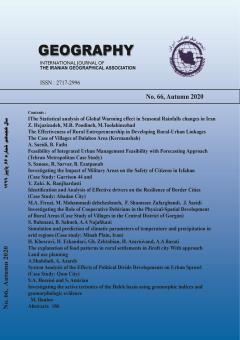The Statistical analysis of Global Warming effect in Seasonal Rainfalls changes in Iran
Subject Areas :zahra hedjazizadeh 1 , mohamadreza poodineh 2 , meysam toulabi nejad 3
1 -
2 - هیات علمی دانشگاه سیستان بلوچستان
3 -
Keywords: climate change, greenhouse gas, methane Gase, precipitation anomalies, Iran.,
Abstract :
Increasing greenhouse gases could increase the frequency of changes in precipitation in different regions of the world. So, identify the effects of global warming on precipitation in a country like Iran which is located in the dry area of the earth is of great importance in planning related to water resources are. According to the study, statistical analysis method used. for analysis, total precipitation data of 34 stations from 1984 to 2012 was received from the National Weather Service. Also data of methane Gase (ppb) as one of the most important factors of global warming, the site of NOAA received. Outset this elements by method The Pearson correlation coefficient determined, afterwards long-term changes in precipitation than was calculated. The results of this study showed that, Bharhdr rainfall in the north and northwest parts of the country grew 13 mm; and Precipitation stations southern half of the country have faced long-term reduction of 46 percent. Due to the increasing amount of greenhouse gases, analysis of the data suggests a reduction of 30 mm of precipitation in summer than long-term stations in southern Iran, but in contrast rainfall in western and northern stations, an increasing of 14 mm. The results showed that the autumn precipitation is most relevant to global warming, in this season, about 24 mm of rainfall western stations to long-term decline, but the Southwest and Southeast stations surged 17 mm have experienced. Finally, the results of the Winters precipitation showed which, the West and Northwest stations were reduced 18/6 mm.
1. جهانبخش، عليرضا؛ ترابي، سيما.(1383)، بررسي و پيش بيني دما و بارش در ايران، فصلنامه تحقيقات جغرافيايي، 74: صص104-125.
2. خسروي، محمود، اسمعيل نژاد، مرتضي، نظري پور، حميد،.(1389)، تغيير اقليم و تاثير آن بر منابع آب خاورميانه، مجموعه مقالات چهارمين کنگره بين المللي جغرافيدانان جهان اسلام، فروردين 1389،صص1-8..
3. خورشيد دوست، محمدعلي؛ قويدل رحيمي، يوسف. (1384)، شبيه سازي آثار دو برابر شدن دي اکسيد کربن جو بر تغيير اقليم تبريز با استفاده از مدل آزمايشگاه پويايي سيالات ژئوفيزيکي(GFDL)، مجله محيط شناسي، 39:صص1-10.
4. دکامي، ارشيا. (1389)، اثر گازهاي گلخانه اي، نشريه نفت و انرژي، صص 57-61.
5. روشن، غلامرضا؛ خوش اخلاق، فرامرز؛ عزيزي، قاسم. (1391)، آزمون مدل مناسب گردش عمومي جو براي پيش بيني مقادير دما و بارش ايران، تحت شرايط گرمايش جهاني، فصلنامه جغرافيا و توسعه، 10(27): 19صص- 36.
6. صلاحي، برومند؛ وليزادۀ کامران، خليل؛ قويدل رحيمي، يوسف، (1386)، شبيه سازي تغييرات دما و بارش تبريز در شرايط دو برابر شدن دي اکسيد کربن جو با استفاده از مدل گردش عمومي مؤسسه مطالعات فضايي گودارد GISS، پژوهش هاي جغرافيايي ،62 :صص55- 66.
7. عباسي، فاطمه؛ بابائيان، ايمان؛ حبيبي نوخندان، مجيد؛ گلي مختاري، ليلا؛ ملبوسي، شراره. (1389)، ارزيابي تأثير تغيير اقليم بر دما و بارش ايران در دهه هاي آينده با كمك مدل MAGICC-SCENGEN، پژوهش هاي جغرافياي طبيعي، 72:صص 91-110.
8. علي¬حسين زهرايي، معصومه. (1387)، خط مشي ها و تدابير حقوقي جامعه ي بين الملل براي کنترل گازهاي گازهاي گلخانه اي، پايان نامه ي کارشناسي ارشد، دانشگاه شهيد بهشتي، پژوهشکده ي علوم محيطي، گروه محيط زيست، شهريور 1387.
9. عزيزي، قاسم؛ کريمي احمدآباد، مصطفي؛ سبک خيز، زهرا .(1384)، روند دمايي چند دهه اخير ايران و افزايش CO2، نشريه علوم جغرافيايي، 4(5): 25صص-42.
10. فرج زاده اصل، منوچهر .(1384)، خشکسالي، از مفهوم تا راهکار، تهران، سازمان جغرافيايي نيروهاي مسلح، چاپ اول.
11. قويدل رحيمي، يوسف. (1385)، ارزيابي حساسيت پذيري دما و بارش تبريز به افزايش دي اکسيد کربن جو با استفاده از مدل هاي گردش جهاني پيوندي جوي- اقيانوسي، فصلنامه مدرس علوم انساني، ويژه نامه جغرافيا، 24:صص 103-123.
12. محمدي، حسي؛، مقبل، معصومه؛ رنجبر، فيروز. (1389)، مطالعه تغييرات بارش و دماي ايران با استفاده از مدل MAGICC SCENGE، فصلنامه علمي-پژوهشي انجمن جغرافياي ايران، 8(25):صص 125-142.
13. مساح بواني، عليرضا.، مريد، سعيد. (1384)، اثرات تغيير اقليم بر منابع آب و توليد محصولات كشاورزي مطالعه موردي: حوضه زاينده رود اصفهان، تحقيقات منابع آب ايران، 1(1): صص47-40.
14. منتظري، مريم؛ فهمي، هدايت. (1382)، اثرات تغيير اقليم بر منابع آب کشور، مجموعه مقالات سومين كنفرانس منطقه اي تغيير اقليم، صص 1-16.
15. نظامي، مهدي. (1389)، بهره برداري از استانداردهاي بين المللي براي مقابله با تغيرات آب و هوايي، نشريه سازمان استاندارد و تحقيقات صنعتى ايران، ماهنامه استاندارد، 221: صص22-33.
16. Frei Christoph, Christoph Schiir, Daniel Liithi and Huw C. Davies(1998), Heavy Precipitation Processes in a Warmer Climate, Geophysical research letters, 25(9):pp1431-1434.
17. Frei, Christoph, Regina Schöll, Sophie Fukutome, Jürg Schmidli and Pier Luigi Vidalem(2005), Future change of precipitation extremes in Europ: an intercomparision of scenarios from Regional Climate models, Atmospheric and Climate Science, ETH, Zürich, Switzerland.
18. Mitchell ,J. B (1989), The Greenhouse effect and Climate change, Reviewso f Geophysics, Meteorologica Office, Brackne!England ,February1989,pps 115-139.
19. Ramanthan, V & Feng ,Y ,(2009), Air pollution, greenhouse gases and climate change: Global and regional Perspective, Atmospheric Environment, 43:pp 37-50.
20. Ramos, M. C. ,. J. C. Balasch ,. J. A. Martínez-Casasnovas,)2012), Seasonal temperature and precipitation variability during the last 60 years in a Mediterranean climate area of Northeastern Spain: a multivariate analysis, Theor Appl Climatol, 26:pp10-29.
21. Raupach. Michael, Fraser. Paul.(2011), Climate and greenhouse gases,Science and solutions for Australi, pp1-33.
22. http://www.esrl.noaa.gov/gmd/dv/data/ .
23. The Story of FAO,2007.
24. WMO, Green house Gas Bulletin, No, 7, November 2011.


